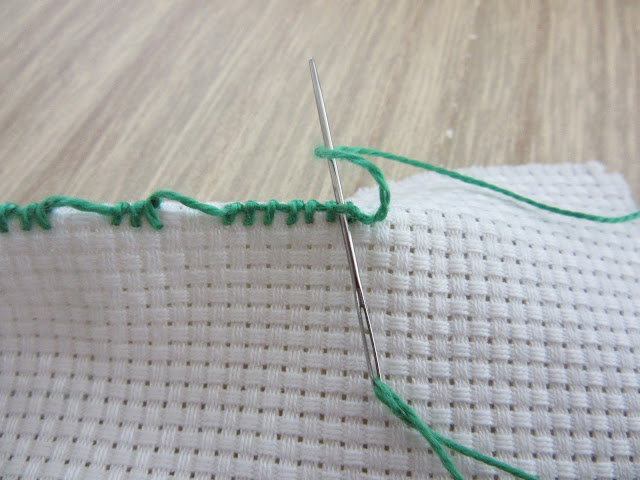Only a needle and some thread is needed to make the decorative Puncetto Valsesiano needle lace from the Valsesia region in Northern Italy. Most commonly it is worked in white, but the Mastallone Valley folk costumes are often decorated with coloured PV needle lace.
Interested to know more? Read this article by Google Arts & Culture.
Instead of making a lace doily, snow flake square or parts of a folk costume, I want to use the Puncetto Valsesiano Stitch as a 3D embroidery stitch.
Work it like this:
First fold the fabric you are working on and stitch right on the fold.
First work from left to right.
To make an open space skip a few stitches while leaving a loop of thread.
When it is time to work the second row don't turn the work over, instead stitch from right to left. Go between the knots, not catching any of the fabric this time.
Work the third row left to right by inserting the needle between the knots.
A note on the twist of the thread. In the examples above I have used perle 8 which has an S twist. (Read more about S and Z twists at Needle 'n Thread.)
When you stitch from left to right with an S-twisted thread, the thread twists itself a bit tighter. When you stitch from right to left (on the return journey) the thread untwists itself.
In both cases, you need to either let the needle and thread dangle for a short time to regain the right twist,
or
you need to learn to roll the needle between your thumb and index finger in a clockwise and anti clockwise direction.
Anti clockwise for left to right stitches.
Clockwise on the return journey.
It IS confusing! With practice you can control the twist 'automatically'.
Homework:
Pay attention to the tension, the twist and leave enough room in each knot to insert the needle on the return journey.
Stitch something high and lacy,
and in the style of free form,
and on plain cloth.










16 comments:
It almost looks like crochet.
Yes, isn't it? However, you can not rip up the stitches. This is one kind of embroidery which is almost impossible to reverse stitch so work slowly and with attention to details.
Looks like a caterpiller! I have never seen this stitch before.
Oooh! This is fascinating! A stitch almost lost! I must find something to test this on! Thank you for sharing, and I look forward to seeing your lacy piece!
Barbara x
You are right! I think you can build all sorts of interesting shapes with this stitch. It reminds me of the 3D laser printers!
Far too many stitches have been in danger of extinction, Mountmellick is another one that needed to be given the 'kiss of life' as it was waning in popularity in the 1970s.
Quilting also lost its popularity and then when new life was blown into it, it has developed into the most fantastic and versatile craft and art form.
Long live stitching!
I agree it looks like crochet and a caterpillar. I imagine some fantastic effects could be created with that stitch. Fun Sunday Stitch School subject, Queenie.
Great lesson and such a pretty stitch.
It is a nightmare to reverse stitch; you can't rip it ump like you can crochet.
Yes, it could be a caterpillar or maybe a bridge in a miniature garden!
The examples and pictures in the link (Google Arts & Culture) really show how beautiful this kind of needle lace can be.
what a ,lovely edging this stitch makes, very interesting too reading about the perle thread which I love to use but did not know about how it twists depending on the direction you stitch in. Have booked a hotel for FOQ will you be bale to come this year?
I have great hopes for this stitch.
Have you ever had problems with the Bullion Knot and how to wind the thread around the needle. Try what happens to it when you wind clockwise and anti clockwise.
I might not be able to visit the FOQ this year, sigh! Sob!
This is a very interesting stitch with lots of posibilities.
YES it is, but you do need good lighting and good eyes!
I have always been curious about needle lace. You did such a great job explaining this stitch. I've always noticed there are times when the twist of a thread requires dropping the needle to allow it to unwind. It was interesting to learn that can be avoided with a roll of the needle.
Bullion Knot is another stitch that loves twisting itself and I think it was something I read by Mary Corbet that made me try the rolling technique. It is a timesaver!
Post a Comment